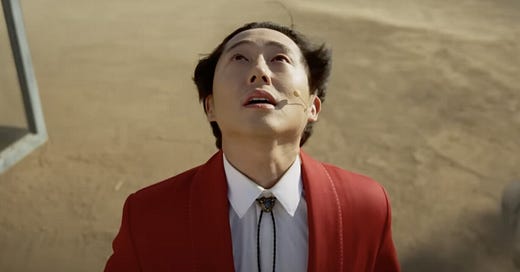In my latest video about Jordan Peele’s Nope, I detail a powerful but somewhat infrequently used technique that I’m calling “Sonic Ambiguity.”
It’s a pretty straightforward idea; in the same way you can create a shot that is ambiguous visually, you can craft sounds that leave the audience questioning what they just heard.
Spielberg does this in Jaws pretty early on. There’s a scene where Chief Brody sits on a crowded beach anxiously watching for a shark. At one point a girl screams, and it sounds like a horrified scream, but we quickly find out she was just playing around. Brody (and the audience) are momentarily fooled.
In this example the meaning of the sound is ambiguous, but the sound itself is not. We know we’ve heard screaming, we just don’t know what it means.
Nope pushes this idea a little bit further. I don’t want to spoil the film here, but the sound design of the UFO is itself ambiguous. You’re not just unsure of what the sound means, you’re unsure of what the sound is. You can hear my explanation and the sounds in the video essay.
One thing I don’t mention in the essay is how ambiguity is also created in Nope by using “sonic rhyming” throughout the film. If you pay close attention, there are sounds from the UFO storyline that sound similar to threatening or scary sounds from the “Gordy’s Home” storyline. Even though they’re not directly related, Peele imbues certain sounds with tension or meaning, and then spooks us by invoking similar sounds in other places in the film.
Lynne Ramsay’s 2011 psycho-thriller, We Need to Talk About Kevin, is narratively structured around ambiguity. We experience the childhood of Kevin through the memories of his mother (played wonderfully by Tilda Swinton) as she copes with the aftermath of his killing spree.
[It’s a great film, with a lot of layers to interpret, an impressive style, and really dreadful atmosphere. Ramsay has such a strong directorial voice and the film’s use of color, subjectivity, and sound are all very powerful. I won’t spoil any of the plot the film’s marketing doesn’t spoil below, but if you prefer to avoid “experiential spoilers” and you want to watch it, you might want to avoid this section.]
There’s a really powerful moment of sonic ambiguity in the film: as Kevin’s mother arrives at the scene and Kevin is brought by police out in front of horrified onlookers, the shocked screams of the crowd seem to be… cheering. It’s a wickedly sharp maneuver on Ramsay’s part that makes the scene all the more unsettling while also cutting to the heart of perhaps part of why those kinds of violent acts are committed.
It’s no coincidence that this film uses this kind of ambiguity and is also a movie that— like Nope— is thematically exploring the idea of our attraction to spectacle.
If you’re interested in why ambiguity like this is so closely linked to suspense and horror, I definitely recommend Matthew Morgan’s essay on the topic:
“What powers terror is ambiguity itself. It is the potential that our imagination taps, conjuring countless possible things behind the door… …Humans don’t like to live with so much uncertainty. Show me the ghost, our terrified subconscious begs, so I can be done with this tension.”
I know it’s been a while since you’ve heard from me, thanks for sticking around. Regular videos are still going up on the channel, and I talk about a film every week on my podcast Cinema of Meaning. I will continue writing here when inspiration strikes.






Great post. I'm reminded of another great moment of sonic ambiguity. In David Lynch's Wild at Heart, Nicolas Cage performs Elvis' Treat Me Like a Fool, adoring female fans scream as he sings, but if you listen carefully, they are screams of terror, which subtly contributes to an unsettling atmosphere.
🔊